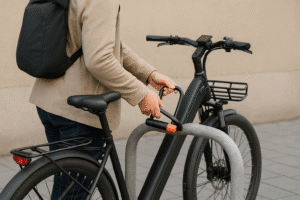E-bike batteries are built to handle everyday charging, but overcharging them can still cause real problems.
Leaving your e-bike plugged in for too long stresses the lithium-ion cells, reduces lifespan, and in some cases may lead to safety risks.
If you’re wondering how dangerous overcharging really is and how it affects performance, here’s what you need to know.
Key Summary:
- Overcharging strains lithium-ion cells and shortens battery life.
- Risks include overheating, swelling, chemical breakdown, and rare fire hazards.
- Modern e-bikes have Battery Management Systems (BMS), but poor chargers or neglect can still cause issues.
- Smart charging habits (timers, auto shutoff, avoiding overnight charging) protect both the rider and the battery.
What Does Overcharging Mean for E-Bike Batteries?
Overcharging an e-bike battery happens when the battery stays connected to the charger after it has already reached 100%. This forces excess voltage into the lithium-ion cells, which can cause overheating, swelling, and long-term damage.
Think of it like pouring water into a glass that is already full. At first, the overflow may look harmless, but over time, it causes a mess, waste, and even cracks in the glass.
In the same way, overcharging slowly wears down the chemical structure inside your battery.
Modern e-bikes often have Battery Management Systems (BMS) to prevent this, but the risk remains if you use cheap chargers, faulty batteries, or leave your battery charging for days at a time.
Is Overcharging E-Bikes Dangerous?
Yes, overcharging an e-bike can be dangerous. While fires and explosions are rare, overcharging creates heat and pressure inside the battery that can damage the cells, shorten battery life, and in extreme cases, lead to hazardous conditions.
The most common risks include overheating, swelling, chemical breakdown, and performance decline. Over time, this stress makes your battery less reliable, increases the chance of sudden failure, and raises the cost of replacement.
In poorly ventilated areas or with uncertified batteries, overcharging can also create fire hazards, which is why many cities now highlight safe charging practices.
The good news is that most branded e-bikes and chargers have built-in protection against true overcharging. But no system is foolproof.
Riders still play a key role in battery safety by unplugging once the charge is full and charging in a cool, safe space.
How Overcharging Impacts Battery Lifespan and Performance
Overcharging doesn’t just pose safety risks. It also cuts into your battery’s usable life and makes everyday rides less efficient.
Fewer Charge Cycles
Lithium-ion batteries are designed to last through hundreds of charge cycles. Overcharging reduces this number by 20–30%, meaning you’ll need a replacement battery sooner.
Shorter Range per Charge
As capacity declines, your rides get shorter. What once took you 40 miles on a full charge might only cover 28–30 miles after repeated overcharging.
Slower Charging and Discharging
Damaged cells create more internal resistance. That means your battery may take longer to charge and release energy less efficiently, leaving you with weaker acceleration and inconsistent power delivery.
Higher Long-Term Costs
Since e-bike batteries are one of the most expensive components (often $400–$900), frequent overcharging can hit your wallet hard. Replacing a battery earlier than expected adds up over the years of ownership.
Safety Risks of Overcharging E-Bike Batteries
Overcharging doesn’t just shorten battery life; it can also create safety issues if left unchecked. The build-up of heat, gas, and pressure inside lithium-ion cells can cause physical damage and, in rare cases, hazardous failures.
While modern batteries are safer than older models, understanding these risks helps riders avoid costly or dangerous situations.
Here’s a quick breakdown of the main risks:
| Risk | What Happens |
|---|---|
| Overheating | Extra heat warps the casing and damages internal chemistry. |
| Swelling | Gas buildup pushes the battery outward, making it expand or deform. |
| Chemical Breakdown | Internal reactions permanently damage the cells. |
| Fire & Explosion (rare) | Severe cases can ignite fires, especially in enclosed spaces. |
Warning Signs Your Battery May Be Overcharged
Catching the problem early is the best way to prevent damage. If your e-bike battery shows these warning signs, it may be suffering from overcharging:
- Battery swelling or bulging that makes it hard to fit in the frame.
- Excess heat during or after charging, even on short sessions.
- Unusual odors like burnt plastic or chemicals near the battery.
- The charge indicator is stuck at 100% but the battery drains quickly.
- Sudden performance drops, such as reduced range or weak acceleration.
Best Practices to Prevent Overcharging
A few simple charging habits can go a long way in protecting both your battery and your safety:
- Unplug after a full charge instead of leaving it connected for hours.
- Use the original charger supplied by the manufacturer, not cheap third-party models.
- Charge in a cool, ventilated space away from flammable materials.
- Set timers or use smart plugs to automatically cut off power after a set time.
- Avoid overnight charging unless your charger has a proven auto shutoff.
- Store at 50–70% charge if you won’t be riding for weeks, such as in winter.
- Inspect your battery regularly for swelling, cracks, or heat damage.
Do All E-Bike Batteries Have Overcharge Protection?
Yes, most modern e-bike batteries include overcharge protection through a built-in Battery Management System (BMS). These systems stop charging once the battery reaches full capacity and balance the cells to prevent overvoltage.
However, not all batteries are created equal. Premium brands typically use advanced BMS with multiple layers of safety, while cheap or counterfeit batteries may lack these protections altogether. Even with a good BMS, user habits still matter.
Leaving a battery connected for days at a time, charging in hot spaces, or using non-certified chargers can stress the cells beyond what the system can handle. That’s why rider vigilance is still key.
Buying Tips for Safer Batteries and Chargers
The safest way to avoid overcharging issues is to buy high-quality batteries and chargers from trusted brands. Always choose products that come with certified safety features such as UL or CE markings, and stick with chargers designed specifically for your e-bike model.
Cheap or unbranded batteries may skip proper safety systems, putting you at higher risk of overheating or fire.
Investing in a reliable battery and charger might cost more upfront, but it saves money long term by extending lifespan and protecting your ride.
If possible, pair your charger with a smart plug or timer to add an extra layer of safety.
Final Words
Overcharging an e-bike battery is not something to take lightly. It reduces lifespan, weakens performance, and in some cases creates real safety risks.
While modern batteries include protective systems, good charging habits remain the best way to keep your battery healthy.
Unplugging after a full charge, charging in safe conditions, and avoiding cheap equipment will help your battery last longer and keep your rides trouble-free.
A little care now means fewer replacements later and safer trips every time you ride.
FAQs
Can I leave my e-bike battery charging overnight?
Leaving an e-bike battery charging overnight is generally safe if you use a certified charger with automatic shutoff, but it’s still better to unplug once full to avoid unnecessary stress on the cells.
Do modern lithium-ion batteries stop charging on their own?
Modern lithium-ion batteries usually stop charging on their own thanks to built-in Battery Management Systems, but this protection is not foolproof, especially with low-quality chargers.
What happens if my battery swells?
If your battery swells, stop using it immediately. Swelling means internal damage, and continuing to use it could be unsafe.
Is it bad to charge my e-bike to 100% every time?
Charging to 100% occasionally is fine, but doing it every time can shorten the lifespan. For daily use, charging to around 80–90% helps preserve capacity.
What should I do if I suspect my battery is damaged?
If you suspect your battery is damaged, stop charging, avoid riding with it, and have it inspected or replaced by a qualified technician.
Michael Josh is a hands-on e-bike tester and reviewer at BoltBikers, known for putting every model through real-world rides before sharing his thoughts. With a sharp eye for performance, comfort, and build quality, he helps the team choose which bikes are worth featuring. Backed by years of experience in tech and gear reviews, Michael brings trusted, honest insights to help readers find the right e-bike for their needs.








